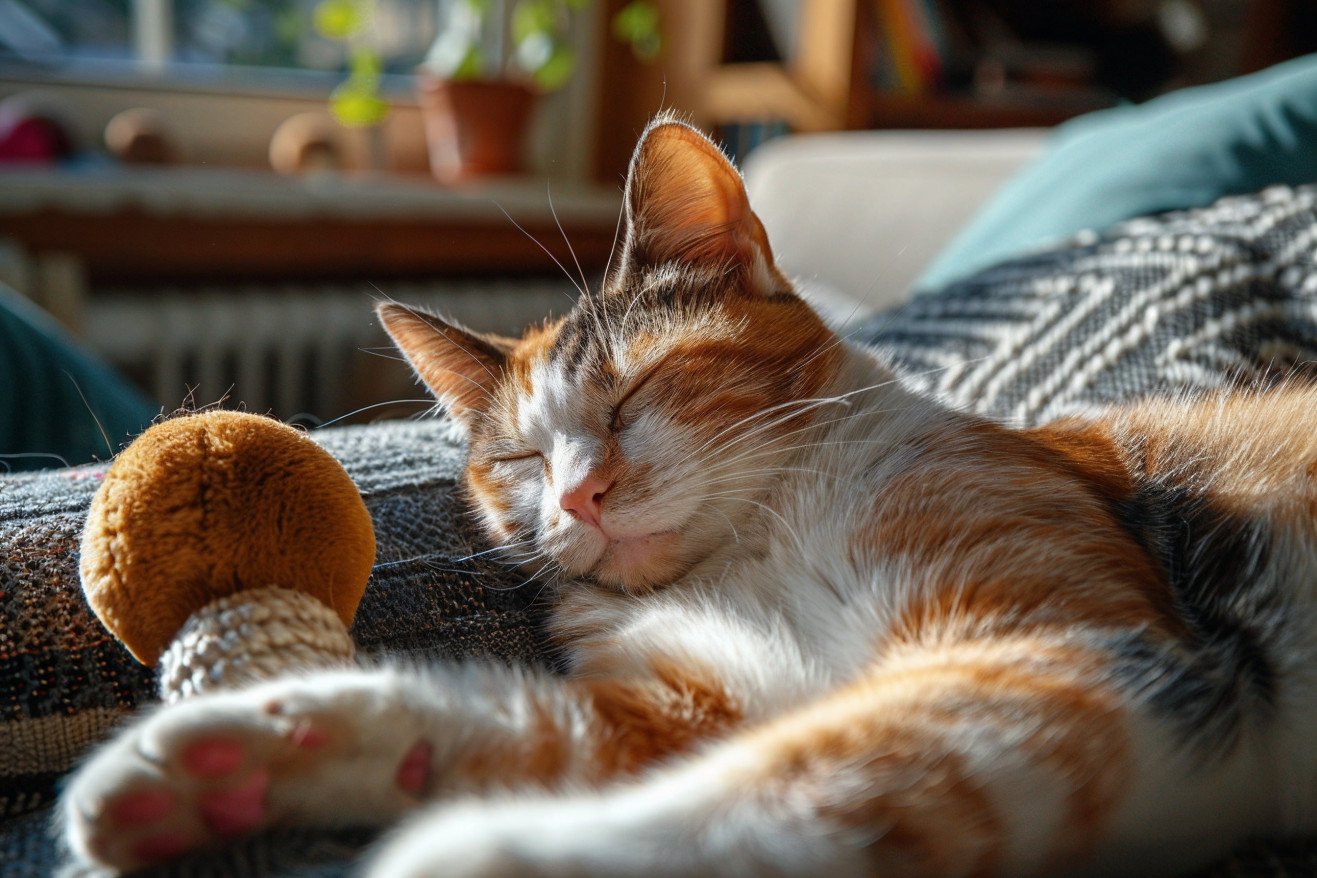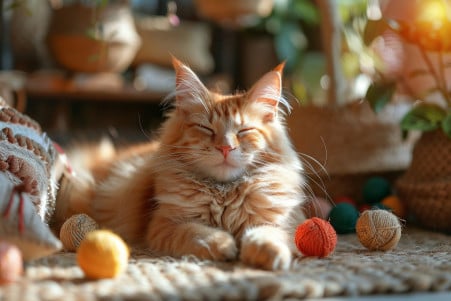How to Tell if Your New Cat is Adjusting: How to Know When Your Cat is Happy
18 March 2024 • Updated 17 March 2024

How can you tell if your new cat is happy and adjusting to its new home? Signs that a new cat is adjusting include exploring, eating and grooming, showing curiosity, and seeking out your attention or affection. Other signs of a happy, well-adjusted cat include sleeping, using the litter box, and playing.
This article draws on the latest research in feline behavior to take a closer look at a number of studies and papers by veterinary scientists and animal behaviorists. Their work is a valuable resource for understanding the many ways that cats communicate that they are happy and comfortable in their new home.
By the end of this article, you will have a better idea of how to help your cat through the adjustment period and deepen your relationship with your new furry friend.
How can you tell if your new cat is adjusting?
Behavioral Signs of a Happy Cat
There are several behaviors that are clear signs that a new cat is starting to feel more comfortable in their new environment. These include a cat’s willingness to explore and play, which shows that they are starting to feel more secure and curious. According to PetHelpful, a kitten that is willing to play, especially with interactive toys like a cat wand, is happy and wants to bond with their human family.
Eating and grooming are also important because they show that a cat is not too stressed. According to VerveCat, eating and grooming are signs that a cat is comfortable enough to take care of their basic needs without feeling threatened.
Another good sign is when a cat is seeking out human contact and affection. When a cat is willing to initiate contact, like rubbing against your leg or nudging your hand, it shows that they are comfortable and trust you, according to PetHelpful. A cat’s comfort with sleeping and using the litter box are also good signs that a cat is adjusting well to their new home and feels safe.
If your cat is showing these signs, you can be confident that they are adjusting to their new home. It’s also important to make sure that you are meeting their dietary needs, as a cat that is adjusting well will have a good appetite and will show a clear preference for certain foods.
Dietary Cues of Feline Adjustment
One of the most important ways to tell if your new cat is adjusting is by paying attention to its eating habits. A well-adjusted cat will have a healthy appetite, which is a sign that it feels safe and secure in its new home.
On the other hand, a cat that is stressed will eat less, or it may change its eating habits, according to a study on PMC. These changes in eating habits can be a sign that your cat is having a hard time adjusting and may need some extra help.
In addition to eating habits, the timing of meals is also important. The same study on PMC found that cats are creatures of habit, and having a regular feeding schedule can help them feel more secure in new and potentially stressful situations.
In addition, the type of food you feed your cat is also important. Cats will feel more secure if they are eating food that meets their nutritional and instinctual needs. In addition, feeding your cat a variety of foods that meet its needs can help make it feel more secure.
It’s also important to understand the connection between eating habits and emotional well-being. For example, feeding your cat food puzzles, as recommended by the website Food Puzzles for Cats, can help stimulate your cat’s natural foraging instincts and improve its mental well-being. By paying attention to these dietary and behavioral cues, you can help your cat become a happy, well-adjusted member of your family.
Signs of Stress That May Impede a Cat’s Adjustment
Not all cats will take to their new home right away, and there are some signs that your cat may be having trouble adjusting. According to the Merck Veterinary Manual, changes in a cat’s elimination patterns and increased aggression are signs that a cat may be experiencing anxiety or stress.
Meanwhile, International Cat Care notes that a cat that is stressed may become withdrawn and quieter, and this can be harder to detect, especially if the cat’s eating, grooming, and social behaviors are changing.
The amount of time it takes for a cat to adjust to a new home can vary greatly, and a cat’s age, personality, and past experiences all play a role. A study published in PMC found that cats that had a history of living in a shelter or being rehomed multiple times may develop non-adaptive coping strategies as a result of past stress, which can delay the development of a cat’s sense of security.
Cats show their emotional states through their behavior, and cats that are stressed will show this by being more still, crouching, and avoiding interactions, as opposed to the exploration and play that a cat that feels secure will exhibit.
It’s important to understand these behaviors so that you can help your cat in the best way possible. The Merck Veterinary Manual suggests that creating an enriched environment that allows cats to engage in their natural behaviors, such as climbing and scratching, can help reduce stress and make the adjustment period easier.
Environmental Enrichment to Help Your Cat Adjust
One of the most important things you can do to help your cat adjust to a new home is to create an environment that is as close to their natural habitat as possible. Environmental enrichment, which involves adding things to your cat’s environment that meet their instinctual needs, has been shown to reduce stress and encourage positive behaviors.
A study published in PubMed even found that environmental enrichment can help prevent anxiety and stress-related disorders.
International Cat Care explains that cats are happiest in environments that allow them to climb, hide, and explore. This means that you can help your cat feel more at home by providing them with tall scratching posts and shelves that allow them to survey their territory from a high vantage point.
This will help them feel safe and in control. Interactive toys and puzzles, as explained by Clinician’s Brief, can help stimulate your cat’s hunting instincts and encourage physical activity, which can help with mental stimulation and reduce the risk of obesity and other health problems that come with being sedentary.
Research has shown that cats who are provided with environmental enrichment are less likely to exhibit behavioral problems and have a better quality of life. However, it’s not just about the things you add to your cat’s environment. It’s also important to understand and meet your cat’s individual needs to help them adjust to their new home.
Knowing a Cat’s History Can Help You Help Them
The web of a cat’s past, especially in terms of shelter life or multiple rehoming experiences, can have a big impact on how well they adjust to a new home.
A review in PMC explains that cats’ sensitivity to change means that the stress of shelter life can lead to stress-induced changes in behavior, such as changes in eating, grooming, or litter box habits. This stress can be indicated by both physical and behavioral signs, which can signal that the cat will have a harder time adjusting.
Knowing the psychological background of a cat that has been in a shelter is important. The same PMC review explains that past instability can lead to high levels of stress that can lead to long-term behavioral changes that may need to be addressed with specific interventions. Creating an environment that caters to a cat’s needs based on their past can help reduce stress and make the transition easier.
Research has shown that it’s important to give individualized care to a shelter cat when you bring it home. A study by Heidi M. Broadley found that cats that came from single-cat and multi-cat homes had different stress responses when they were in shelters, which then impacted how well they adjusted to their new homes.
To make sure you’re giving the best care, take into account a cat’s individual history, which can help improve their quality of life and make the transition easier, leading to a better life together.
Cultivating a New Beginning: Final Thoughts on Cat Adaptation
From behavioral cues to dietary habits, we’ve seen that cat adaptation is a complex process. The confident play, consistent grooming, and regular eating habits are all signs of a well-adjusted cat. However, we’ve also seen that there are signs of stress that we need to be aware of, such as a cat’s tendency to withdraw or changes in their daily routine.
Cat parents need to be understanding and observant as they help their cats through the process of adaptation. Each cat’s experience is different and will be shaped by their past, including their time in a shelter or previous homes. However, with the right kind of care and an enriched environment, cat parents can help their cats feel safe and secure in their new surroundings.
In the end, learning to recognize the signs of a cat’s adaptation is a process of learning and compassion. Creating a safe and loving environment for your cat is about more than just meeting their physical needs, it’s about establishing a relationship that will ensure your cat is content and well for the remainder of their life.
This is the beginning of a long and loving relationship with your cat as they adapt to their new life with you.


